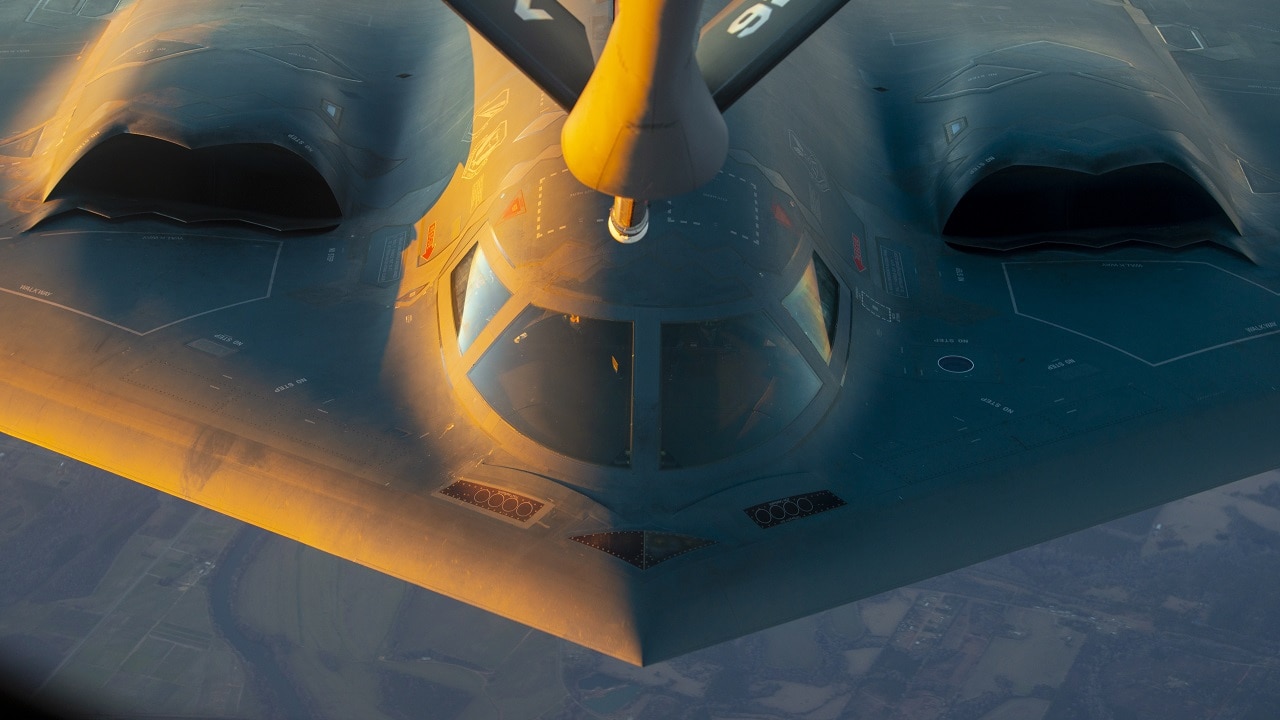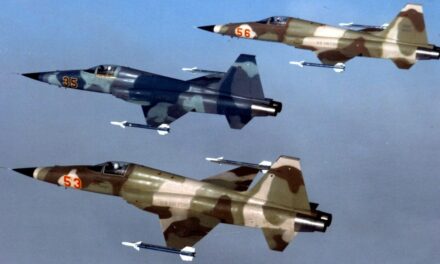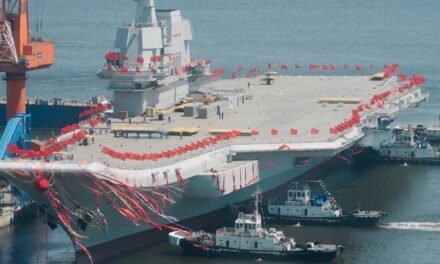We support our Publishers and Content Creators. You can view this story on their website by CLICKING HERE.
Key Points: In October, the U.S. military used B-2 Spirit stealth bombers to strike five underground Houthi weapons storage facilities in Yemen. This marked the B-2’s return to combat after a seven-year hiatus and demonstrated its ability to penetrate hardened, fortified targets.
-Designed for strategic stealth and precision, the B-2 remains a key component of the Air Force’s Global Strike Command, capable of both conventional and nuclear strikes.
-While slated for replacement by the B-21 Raider, ongoing upgrades like Spirit Realm 1 ensure the B-2 remains effective in modern, contested environments.
Why the Aging B-2 Bomber Still Dominates Modern Warfare
In October, the U.S. military conducted a surprising strike against Houthi positions in Yemen. American B-2 Spirit stealth bombers targeted and destroyed Houthi munitions used to attack commercial shipping and Western warships in the Red Sea and the Gulf of Aden.
A practical strike to curb the dangerous Houthis, the B-2 operation was designed to also send a message to America’s near-peer adversaries.
According to the Pentagon, the Spirit stealth bombers leveled five hardened underground weapons storage facilities in Houthi-controlled areas of Yemen. The Houthis used the underground facilities to store munitions – like ballistic missiles, anti-ship cruise missiles, and unmannered aerial vehicles – used to attack international maritime traffic and Western warships in the region.
“This was a unique demonstration of the United States’ ability to target facilities that our adversaries seek to keep out of reach, no matter how deeply buried underground, hardened, or fortified,” U.S. Secretary of Defense Lloyd Austin said in a press statement the day following the strikes.
“The employment of U.S. Air Force B-2 Spirit long-range stealth bombers demonstrate U.S. global strike capabilities to take action against these targets when necessary, anytime, anywhere,” Austin added.
Although an aging platform that will be replaced soon, the B-2 Spirit remains the U.S. Air Force’s sole stealth operational strategic bomber. And, despite its age, it’s an incredible aircraft.
A U.S. Air Force B-2 Spirit “Stealth” bomber, 393rd Expeditionary Bomb Squadron, 509th Bomb Wing, Whiteman Air Force Base, Mo., flies over the Pacific Ocean after a recent aerial refueling mission, May 2, 2005. The Bombers are deployed to Anderson Air Force Base, Guam, as part of a rotation that has provided the U.S. Pacific Command a continous bomber presence in the Asian Pacific region since February 2004, enhancing regional security and the U.S. commitment to the Western Pacific. (U.S. Air Force photo by Tech Sgt. Cecilio Ricardo) (Released)
Why the B-2 Bomber Still Rules
A strategic stealth bomber with the ability to carry both conventional and nuclear munitions, the B-2 Spirit is a main tool in America’s bomber fleet and, alongside the B-1 Lancer and B-52 Stratofortress, makes up the Air Force’s Global Strike Command’s fleet of bombers.
The sleek-looking bomber first flew in 1989; entered service with the Air Force in 1993; and achieved full operational capability in late 2003. The aircraft was first used in the air campaign against the Serbian forces in 1999. During that operation, the B-2 was responsible for destroying one-third of Serbian targets in just eight weeks of missions. During the invasions of Afghanistan and Iraq, the B-2 fleet often flew missions from its home base in Missouri, delivering millions of pounds of munitions thousands of miles away. The last time the B-2 Spirit was used in combat, before the strikes against the Houthis this October, was against ISIS forces in Libya in 2016.
In terms of capabilities, the B-2 Spirit is a powerful, though aging, aircraft. With a crew of just two (compared to the B-1’s four and the B-52’s five), the B-2 can carry around 40,000 lbs of munitions. Its four General Electric F118-GE-100 engines produce a combined thrust of 68,000 lbs and achieve maximum speeds of around Mach 0.9 (or 700 miles per hour). But what makes the B-2 Spirit stand out among the Air Force’s bomber fleet is its stealth capabilities. Through a combination of designed, special paint, and onboard sensors, the B-2 achieves good stealth against adversary radars, thus making it the go-to option for deep-penetration strikes in non-permissive operational environments.

U.S. Air Force B-2 Spirit aircraft undergo pre-flight inspections prior to take off at Andersen Air Force Base, Guam, Aug. 11, 2016. More than 200 Airmen and three B-2s deployed from Whiteman Air Force Base, Mo., to conduct local sorties and regional training and integrate with regional allies in support of Bomber Assurance and Deterrence missions. (U.S. Air Force photo by Tech. Sgt. Miguel Lara III)
The Air Force wants to replace the B-2 Spirit with the B-21 Raider: for its future bomber fleet, the Air Force wants a combination of B-21 Raiders and B-52 Stratofortresses.
Yet, despite the plan to replace the B-2 with the B-21 Raider in the coming years, the Air Force is currently spending money to upgrade the B-2 fleet and make sure that it can operate in a 5th-generation battlefield. But until then, the aircraft remains fully operational against both smaller threats, like the Houthis, and near-peer adversaries like China and Russia. Indeed, the Air Force even used the B-2 Spirit in a QUICKSINK exercise, which aimed to test cost-effective methods to taking out naval threats, in the Indo-Pacific.
Recently, Northrup Grumman, the aircraft’s manufacturer, rolled out the Spirit Realm 1 upgrade designed to bring the stealth strategic bomber up to modern standards through software upgrades. The upgrades will enable the aircraft to carry more advanced and future weapon systems.
Today, as the strikes against the Houthis showcased, the B-2 Spirit remains at the tip of the spear of the Air Force’s global strike capabilities.

A B-2 Spirit assigned to Whiteman Air Force Base, Mo., prepares to receive fuel from a KC-135 Stratotanker, Feb 7, 2021. A B-2 Spirit performed alongside a B-1B Lancer and a B-52 Stratofortress for the Super Bowl LV flyover on Feb. 7, 2021. (U.S. Air Force photo by Airman 1st Class David D. McLoney)
About the Author
Stavros Atlamazoglou is a seasoned defense and national security journalist specializing in special operations. A Hellenic Army veteran (national service with the 575th Marine Battalion and Army HQ), he holds a BA from the Johns Hopkins University, an MA from the Johns Hopkins’ School of Advanced International Studies (SAIS), and is pursuing a J.D. at Boston College Law School. His work has been featured in Business Insider, Sandboxx, and SOFREP. This first appeared in Sandboxx News.

 Conservative
Conservative  Search
Search Trending
Trending Current News
Current News 





